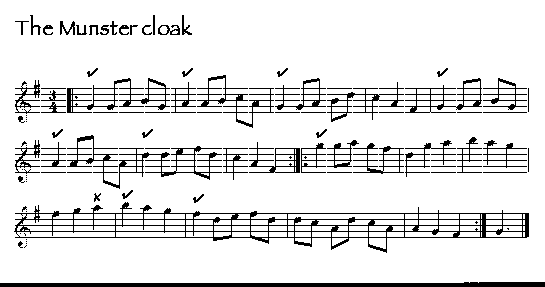Where do I breathe?
The difficulty
Figuring out when to breathe poses problems for almost everyone learning to play Irish music on the tin whistle or flute. You'll run into difficulty as soon as you start to play dance music.
Unlike, say, classical music written for the flute, in which the composer or arranger will allow for places to breathe, Irish dance music is a non-stop flow of music. After all, pipers, fiddlers, accordionists, banjo players and everyone else don't need to stop for breath, and so the tunes come as seamless units. You have to figure out where to breathe.
In fact, the art of breathing is almost to make your breaths a feature of the music. While classical players strive to make their breathing inaudible, traditional musicians allow their intakes of breath to be quite clearly heard. Certain styles of traditional flute playing, in particular, use the breath as a distinct rhythmic device.
As with tonguing, if you've played other types of music on a
wind instrument, you'll find that some of your instincts need
to be unlearned. Irish musicians breathe in places that may
seem very odd to classical players, but they know best!
For example, as a beginner your instinct will probably be to
take a breath at the end of each section, or part. There are
two problems with this approach. The biggest problem is that for
most dance tunes you'll need to breathe more often than that.
The other problem is that, even if you were able to keep going
until the end of each section, always breathing in the same place
would quickly make your playing monotonous.
Basic rules
Here are a few general rules to bear in mind before we look at some specific examples.
-
In dance music, you must never hold up the beat by taking a breath.
This gives you two choices when deciding where to breathe:
You must either shorten a note, or sacrifice one entirely, to make space for yourself to breathe. - Whenever you need to take a breath in the middle of a tune, breathe immediately after an important or strong note, never immediately before. Breathing before a key note will destroy the flow and momentum of the tune.
- Don't always breathe at the ends of sections. Not doing so will allow you to keep the flow of the tune going very attractively.
- Don't always breathe in the same places in a tune. Your playing will soon become monotonous to the listener.
Example: The Munster cloak
Here's a tune, The Munster cloak (sometimes called
The Spanish cloak), to demonstrate all the principles
listed above.

The ticks or check marks indicate quarter notes that you can easily shorten in order to snatch a breath. We could use any of these places to breathe (obviously not all of them). The cross is there just to show you a very bad place to take a breath.
|
|
The Munster cloak, taking breaths by shortening quarter notes (190K) |
This clip demonstrates all the "basic rules". First, shortening a note. Although it is not really a dance tune (please don't insult this noble piece by calling it a waltz!) we certainly want to observe the rule of not holding up the beat. (These quarter notes gave us all the space we needed, so there was no need to sacrifice a note to breathe.)
Second, breathing after a strong note. All these checked quarter notes carry weight in the flow of the melody. What happens if we breathe before an important note? Listen to the repeat of the second line -- I breathe at the cross. The high B in the 5th bar of the second part is, to my mind, the melodic climax of the tune. When I breathe before this note, I really spoil the tune!
Third, the clip demonstrates not breathing at the ends of sections. In this tune (as in many others) the sections flow into each other by means of linking notes. It would be a mistake to breathe during these transitions -- again, we would ruin the flow of the melody. (Although as you surely noticed I contrived to do this at the end of the first part by flubbing a note.)
Fourth, the clip shows not always breathing in the same place. This is important:
in this music, which is by nature repetitious, we have to avoid a feeling of deadly predictably --
we need to keep ourselves, the tune and the listener awake by varying the tune. We can vary the melody,
of course, but we can avoid rigid breathing patterns.
![]() I may get around to adding more examples in time. In the meantime, the topic
on jigs addresses, among other issues, sacrificing a note to allow
for a breath.
I may get around to adding more examples in time. In the meantime, the topic
on jigs addresses, among other issues, sacrificing a note to allow
for a breath.
Next page: Not lifting a finger
Previous page: A few words about tonguing
Site contents: Back to the home page
Updated: 3 August 2001

